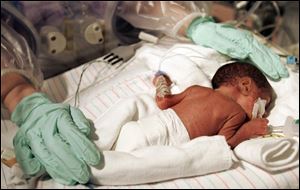
FEATURED EDITORIAL
Save the babies
12/31/2015
Ohio’s infant mortality rate continues to exceed the national rate, and is significantly higher than rates in other industrialized nations.
In an election year, will Ohio politicians pay attention to constituents who don’t vote or make campaign contributions? They’ll have to, if our state is to reduce its excessive infant death rate in 2016.
In 2014, the Ohio Department of Health recently reported, 955 infants died before their first birthday. That’s a rate of 6.8 deaths for every 1,000 live births in the state. (Figures are not available for this year.) Although that overall rate was slightly lower than in 2013, the mortality rate among African-American infants in Ohio increased to 14.3 deaths — nearly three times the rate for white babies.
Ohio’s infant mortality rate continues to exceed the national rate, and is significantly higher than rates in other industrialized nations. Greater Toledo is one of nine metropolitan areas across the state that account for half of the deaths of white infants and nearly all of the deaths of black babies.
Click here to read more Blade editorials
Pre-term birth remains the leading cause of infant death, and 10.3 percent of Ohio babies are born prematurely — also one of the nation’s highest rates. Again, these rates are higher for African-American and Native American babies. The March of Dimes advocates birth spacing and treatment involving the hormone progesterone as ways to reduce premature births.
A campaign against infant mortality also must seek to limit the prospect of fatal birth defects and to reduce sleep-related deaths. To an extent, this is a matter of public information: reminding expectant mothers of the dangers of smoking, drinking, and drug-taking during pregnancy, and of making sure, after babies are born, that they sleep alone, on their backs, in a crib.
But it also is a question of policy priorities in the Statehouse. The state needs to invest more in prenatal care and related services such as housing and transportation, especially for poor women. Instead, Gov. John Kasich and the Republican-controlled General Assembly are waging a partisan campaign to deny state funding to Planned Parenthood, which offers vital family-planning services.
Some useful initiatives are under way. The state budget now provides money for services such as home visits and mental-health checks for mothers-to-be in communities where infant death rates are highest.
Legislative leaders and officials of the Kasich administration say they are making meaningful efforts to keep more babies alive and looking for new strategies to pursue. These approaches ought to include encouraging medical research into infant death, by both public and private institutions.
Local governments in the Toledo area can do their part. City and county officials can develop and share better data about births. They can work to reduce exposure of babies and young children to toxic lead-based paint at home. They can work with private health-care providers to prevent teen pregnancies.
One way to ensure that Ohio makes no progress on infant mortality in 2016: allow anti-abortion extremists to change the subject and insist that politicians focus on their cause. “Pro-life” activists and abortion rights supporters, and the officials who represent them, should be able to find common ground on the need to save at-risk babies once they are born.
That will require a common resolve that Ohio’s too-high infant death numbers no longer can be tolerated, and an agenda of urgency to address the issue. The quality of that response will indicate whether Ohio is the compassionate, can-do state we prefer to think it is.